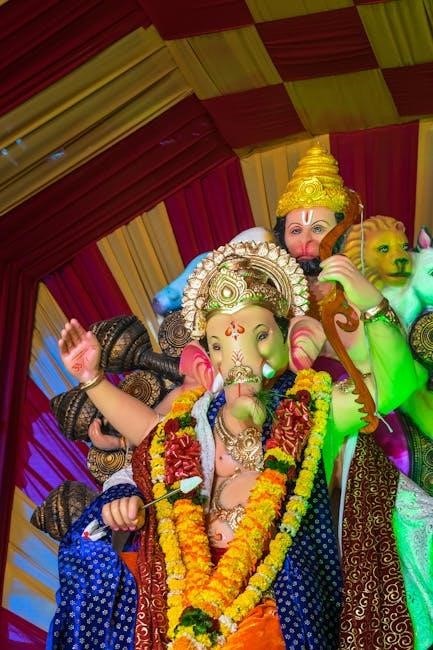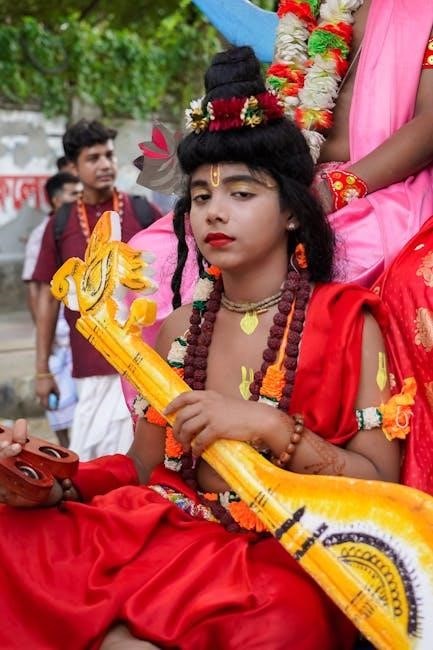Significance and Importance of Varalakshmi Vratham
Varalakshmi Vratham is a sacred Hindu festival honoring Goddess Lakshmi, symbolizing prosperity, wealth, and divine blessings. It is observed to seek her grace for family well-being and happiness.
1.1 Cultural and Religious Background
Varalakshmi Vratham is deeply rooted in Hindu tradition, particularly in Telugu-speaking regions. It is celebrated in the sacred month of Shravana, symbolizing cultural and religious devotion. The festival honors Goddess Lakshmi, embodying prosperity and divine grace. It is primarily observed by married women, reflecting the importance of family well-being and cultural heritage. The rituals are passed down through generations, preserving traditional values and spiritual significance.
1.2 Benefits of Observing the Vratham
Observing Varalakshmi Vratham is believed to bestow numerous blessings, including prosperity, health, and happiness. It strengthens family bonds and ensures the well-being of loved ones. The vratham is also said to grant spiritual growth and material wealth, fulfilling sincere desires. By performing the pooja with devotion, devotees seek Goddess Lakshmi’s grace, believing it brings positive energy and harmony to their lives.
Essential Items for Varalakshmi Vratham Pooja
Essential items include a kalash, coconut, mango leaves, turmeric, vermilion, flowers, and sweets. These items symbolize purity and prosperity, central to the ritual.
2.1 List of Pooja Samagri
The essential items for Varalakshmi Vratham include a kalash, coconut, mango leaves, turmeric, vermilion, flowers, sweets, and betel leaves. Additional items like lamps, incense sticks, and fruits are also required.
2.2 Importance of Each Item in the Ritual
Each item in Varalakshmi Vratham holds symbolic meaning. The kalash represents abundance, mango leaves signify prosperity, and flowers embody purity. Turmeric and vermilion are used for their sacred properties, while sweets and fruits are offerings to the deity. Betel leaves and nuts symbolize longevity and happiness, and lamps signify the illumination of knowledge and prosperity, collectively creating a sanctified atmosphere for worship.

Preparation for Varalakshmi Vratham
Preparation begins a day earlier, involving cleaning the house, assembling pooja items, and decorating the area with flowers and rangolis to create a sacred atmosphere.
3.1 Cleaning and Decorating the Pooja Area
The pooja area is meticulously cleaned and adorned with flowers, rangolis, and sacred symbols to invoke divine grace. On the eve of the pooja, the house is purified with holy water, creating a spiritual ambiance. Families decorate the space with vibrant designs and flowers to welcome Goddess Lakshmi, ensuring a sacred and auspicious environment for the rituals.
3.2 Preparing the Kalash and other Ritualistic Elements
The Kalash is filled with rice, water, and coins, symbolizing abundance. A coconut topped with mango leaves is placed on it, smeared with turmeric and vermilion. Betel leaves, nuts, and flowers are arranged around the Kalash. This sacred setup is believed to attract Goddess Lakshmi’s blessings, ensuring prosperity and harmony in the household.
Detailed Pooja Vidhanam (Procedure)
The pooja begins with invoking Goddess Varalakshmi, followed by rituals like Kalash setup, offerings, and chanting mantras. It concludes with aarti, seeking divine blessings for prosperity.
4.1 Invocation of Goddess Varalakshmi
The pooja begins with the invocation of Goddess Varalakshmi by reciting sacred mantras and performing aarti. Devotees offer flowers, akshatas, and lighting lamps to welcome her divine presence. The invocation seeks her blessings for prosperity, health, and happiness, marking the commencement of the rituals with reverence and devotion.
4.2 Steps for Performing the Pooja
The pooja begins with cleaning and decorating the space. The kalash is filled with water, adorned with mango leaves and coconut. Devotees then perform aarti, chant mantras, and offer flowers and turmeric to Goddess Varalakshmi. The rituals include reciting slokas, performing pradakshinas, and offering naivedyam. Each step is performed with reverence, ensuring adherence to traditional practices for divine blessings and prosperity.
4.3 Offering Naivedyam and Tamboolam
Naivedyam, a sacred offering of food, is prepared with traditional dishes like rice, dal, and sweets. Tamboolam, comprising betel leaves, nuts, and turmeric, is offered to Goddess Varalakshmi. These offerings symbolize gratitude and seek divine blessings for prosperity. The food is later distributed among family and friends, ensuring the spread of positivity and harmony.
4.4 Conclusion of the Pooja with Aarti
The pooja concludes with the recitation of the aarti, a devotional hymn sung to invoke Goddess Varalakshmi’s blessings. Participants circumambulate the deity, seeking grace and fulfillment of desires. Prasadam is distributed, marking the end of the ritual. The ceremony concludes with a final prostration, symbolizing surrender and gratitude to the divine.

Stories and Legends Behind Varalakshmi Vratham
The festival is rooted in mythological tales, highlighting Goddess Lakshmi’s divine grace. Legends recount her benevolence in granting boons and prosperity to devout worshippers, inspiring faith and devotion.
5.1 Mythological Tales Associated with the Vratham
Mythological tales highlight Goddess Lakshmi’s divine intervention in granting boons. The story of Charumathi, a devoted wife, showcases her unwavering faith and the miracles that followed her observance of the Vratham. These legends underscore the significance of the ritual, emphasizing its power to bring prosperity and harmony to families who perform it with sincerity and devotion.
5.2 The Significance of Friday in Shravana Month
Friday in the Shravana month holds immense significance as it is dedicated to Goddess Lakshmi. This day is considered auspicious for worshiping Lakshmi, as it aligns with her divine energy. Observing Varalakshmi Vratham on this day is believed to amplify its benefits, ensuring prosperity, happiness, and the fulfillment of desires. The sacred combination of Shravana and Friday enhances the spiritual potency of the pooja.
Benefits and Mantras of Varalakshmi Vratham
Varalakshmi Vratham brings prosperity, happiness, and divine blessings. Sacred mantras like the Lakshmi Gayatri and Beej Mantras are chanted to invoke Goddess Lakshmi’s grace and ensure fulfillment of desires.
6.1 Spiritual and Material Benefits
Varalakshmi Vratham offers profound spiritual and material benefits, including wealth, health, and family harmony. It is believed to grant divine grace, fulfilling desires and ensuring prosperity; The pooja fosters spiritual growth, cleanses the soul, and strengthens devotion. Observing this vratam is said to bring peace, happiness, and blessings from Goddess Lakshmi, benefiting both personal and familial well-being.
6.2 Important Mantras and their Meanings
Key mantras in Varalakshmi Vratham include the Lakshmi Beej Mantra, “Om Shreem Mahalakshmiyei Namah,” invoking prosperity. The Saraswati Mantra, “Om Aim Saraswatiyei Namah,” seeks knowledge. The Durga Mantra, “Om Dum Durgayei Namah,” offers protection. These mantras, chanted with devotion, connect worshippers to the divine, amplifying the pooja’s spiritual significance and blessings from Goddess Lakshmi.

Regional Variations in Telugu-Speaking Areas
Varalakshmi Vratham holds great significance in Telugu-speaking regions like Andhra Pradesh and Telangana, with distinct rituals and customs varying across these areas, reflecting rich cultural diversity.
7.1 Differences in Pooja Practices Across Andhra Pradesh and Telangana
In Andhra Pradesh and Telangana, Varalakshmi Vratham practices vary slightly. While the core rituals remain consistent, regional customs differ, such as the preparation of specific naivedyam items and the order of pooja steps. Telangana often includes additional folk traditions, whereas Andhra Pradesh incorporates more Vedic chants. These differences reflect the cultural richness and diversity of Telugu-speaking regions, enhancing the festival’s unique charm in each area.
7.2 Local Customs and Traditions
Varalakshmi Vratham is deeply rooted in local customs, with women playing a central role. Married women observe strict fasting, while others perform rituals with traditional items like turmeric and vermilion. The festival is inherited through generations, with mothers-in-law guiding daughters-in-law. Regional folklore and art forms are also showcased, blending spirituality with cultural heritage, making the celebration a vibrant reflection of Telugu traditions and community bonding.

Frequently Asked Questions
Common queries include fasting rules, necessary items, and the significance of rituals. Questions often revolve around correct procedures and the importance of adhering to traditional customs during observance.
8.1 Common Queries About the Vratham
Common questions include the significance of fasting, mandatory rituals, and required items for worship. Many ask about the eligibility of unmarried women and the role of traditional customs. Queries also arise about the correct timing, duration, and the importance of adhering to strict fasting rules. Additionally, people often inquire about the role of ancestors and family deities in the observance of Varalakshmi Vratham.
8.2 Clarifications on Pooja Procedures
Clarifications often focus on the correct steps for invoking Goddess Lakshmi, preparing the Kalash, and performing rituals. Questions arise about the proper timing for pooja, the significance of mantras, and the order of offerings. Additionally, there are queries about the strict fasting rules, the role of traditional items like turmeric and kumkum, and the proper disposal of pooja materials to maintain purity and ensure blessings.
Varalakshmi Vratham is a significant ritual for prosperity and divine blessings, emphasizing tradition and devotion. Performing it with faith ensures happiness and fulfillment in life.
9.1 Summing Up the Key Points
Varalakshmi Vratham is a significant ritual for prosperity and divine blessings, emphasizing tradition and devotion. Observing this vratham ensures happiness, wealth, and family well-being. The pooja vidhanam in Telugu provides detailed guidance, making it accessible for devotees to perform the rituals correctly. By following the steps and maintaining faith, one can seek Goddess Lakshmi’s grace and fulfill their desires.
9.2 Encouraging Readers to Perform the Pooja
Varalakshmi Vratham is a powerful way to invoke Goddess Lakshmi’s blessings for prosperity and happiness. Readers are encouraged to perform the pooja with devotion, following the Telugu PDF guide for accurate rituals. Embracing this tradition strengthens family bonds and brings divine grace into their lives.
By participating wholeheartedly, one can experience spiritual fulfillment and material success. The detailed vidhanam ensures ease of performance, making it accessible for all devotees to seek Goddess Lakshmi’s benevolence.



